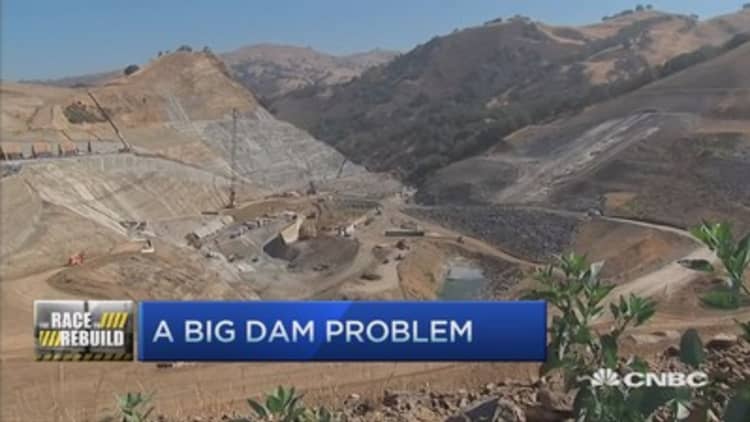
With California mired in a severe, four-year drought, it might seem odd that there's dam demolition underway. But that's exactly what's happening at a 94-year-old dam near Monterey, and it's being done to remove a seismic risk and to aid an endangered fish.
Built in 1921, the sediment-filled San Clemente Dam on the Carmel River was declared earthquake unsafe in 1991 by the state's agency for dam safety and hasn't been anywhere near its capacity in more than a decade. The dam's owner, California American Water (CAW), a unit of utility American Water, was ordered by the regulator to make the dam safe from a large earthquake.
Read More'Shade balls' protect LA water supply during drought
CAW originally proposed spending about $55 million to buttress the 106-foot-tall dam in order to protect the 1,500 homes and buildings downstream. Through a public-private partnership, the investor-owned utility came up with an alternative plan to resolve the safety issue: an $83 million removal of the aging dam and restoration of the Carmel River's fish and ecological habitat.
"The reservoir would fill up and then it would spill over the dam," said Joyce Ambrosius, a Santa Rosa, California-based supervisor with the National Oceanic and Atmospheric Administration's National Marine Fisheries Service. "It's a really important project for us because it will allow the fish to be able to move up the river on their own without trying to get past the dam."
Read MoreSteroids for cattle causing sex changes in fish
The fish she's referring to is the South-Central California Coast steelhead trout, an endangered species. The dam removal will open up access to over 25 miles of spawning and rearing habitat for the steelhead, and also is expected to benefit the California red-legged frog, another species listed as threatened.
"There are lots of community and river benefits in addition to reducing the risk of having a dam that isn't safe in an earthquake," said Kevin Tilden, CAW's manager of external affairs.
Many of the dams with above-average hazard potential were built before 1970.
Within California, 42 percent of the state's dams are privately owned, and more than half of the dams in the total registry (685 dams out of the 1,248 listed) are considered "high-hazard potential," meaning their failure could cause loss of human life, according to the National Inventory of Dams. Nationally, about 17 percent of the dams are categorized as "high-hazard potential."
Read MoreThe drought in water utility stocks is ending: Analysts
According to Tilden, the utility's customers "are still paying the price for the lowest-cost option." CAW customers will pay "between $49 million to $53 million," he said, but the remainder of the cost of the project will be funded from public agencies, including the State Coastal Conservancy, Wildlife Conservation Board and NOAA's National Marine Fisheries Service, as well as the nonprofit Nature Conservancy.
The tear-down project started this month. Workers are removing 7,000 square feet of concrete and reinforced steel from the obsolete dam, which is located about 15 miles southeast of Monterey. The restoration of the adjacent Carmel River will follow.
As part of the overall plan, CAW is donating 928 acres of watershed around the dam to the U.S. Bureau of Land Management.
Read MoreDrought to deluge? El Nino's impact on California
"The exciting thing will be to go there a year from now and see it. It will appear as though a dam was never there," said Tilden.
Officials are hoping for good weather to continue through the duration of the largest dam removal in California's history, although wet weather could throw off the schedule for construction and rehabilitation work, as well as add costs.
"Their permits go until the end of October," said NOAA fisheries official Ambrosius. "With El Nino, we just don't know when the rains will start. If they come earlier than October, then that could mess up the construction season."


